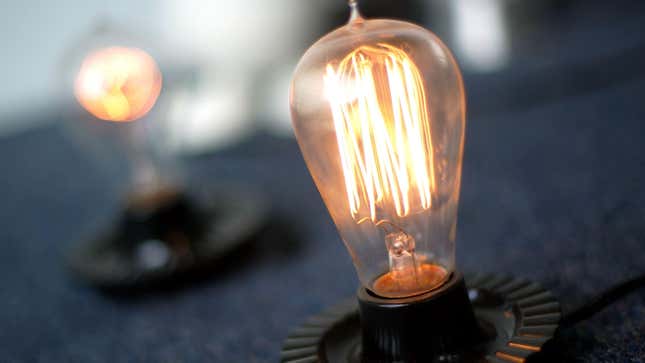
The Department of Energy (DOE) rules around lightbulbs have long been a lightning rod of sorts in American politics. Former president Barack Obama tried to phase out inefficient bulbs, but his successor Donald Trump scrapped the policy. The Biden Administration brought the plan back on track and, starting today (Aug. 1), the sale of energy inefficient lightbulbs will be banned in the US.
A new minimum standard for lightbulbs has been set at 45 lumens—or brightness—per watt. Retailers can’t sell bulbs that don’t meet the criteria, though households can continue using existing bulbs.
Most traditional incandescent and halogen bulbs won’t make the cut. Switching over from older bulbs to newer LED bulbs is meant to “conserve energy and help consumers save on their energy bills,” according to the rule announced in April last year.
Some Republican politicians are disgruntled with the Biden administration dictating choices in consumer households to improve energy efficiency, a debate that has encompassed gas stoves and home appliances like dishwashers. But environmentalists have heralded the move as long-time coming, and believe the industry has had ample time to adapt.
Charted: LED lights are most efficient
Lightbulb energy savings, by the digits
$3 billion: How much the DOE expects consumers to save per year on their utility bills once the new rules are implemented
5%: Share of global greenhouse gas emissions are attributed to lighting
90%: Share of the energy powering incandescent and halogen bulb that’s wasted in generating heat, as these create light by heating a filament. Fluorescent light bulbs use an entirely different method to create light, wasting a far lower 30% of their energy in heat
222 million metric tons: Estimated emissions cut as a result of the DOE rules’ implementation over the next 30 years, equivalent to the emissions generated by 28 million homes in one year.
30%: Share of light bulbs sold in 2020 that were incandescent or halogen, according to industry groups cited in a USAToday report
94%: How much the price of LEDs fell between 1998 and 2016
$4 versus $1: How much LED bulbs cost compared to legacy incandescents, but they last much longer...
...25 to 50 times: How much longer LED lightbulbs last compared to incandescent bulbs
85%: How much less energy LED bulbs use versus traditional incandescent ones
40%: Decrease in US lightbulb shipments over the last decade, as per economist Sarah Armitage’s estimate last May. People are buying fewer lightbulbs because their bulbs last longer
Quotable: Not all incandescent lightbulbs are banned
“It does not ban the sale or manufacture of ALL incandescent bulbs, just those common household incandescent (and other) bulbs that are not energy-efficient...Many bulbs, including specialty bulbs, three-way bulbs, chandelier bulbs, refrigerator bulbs, plant grow lights and others, are exempt from the law’s requirements.” —Environmental Protection Agency (EPA) on its website
A brief timeline of the incandescent light bulb ban
2007: On his campaign trail, presidential hopeful Barack Obama promises to phase out all incandescent light bulbs. Two months later, George W Bush signs the Energy Independence and Security Act (EISA), which establishes several energy management goals, including a new efficiency standards for “general service” lightbulbs.
2012: The law requires most new screw-based lightbulbs to use 28% less power than existing incandescent lights, essentially ending the sale of the older, inefficient lightbulbs. Since incandescent bulbs have a short lifespan—about a year—consumers start switching to energy-saving bulbs fairly quickly.
2014: Obama-era regulation, due to take effect on Jan. 1, 2020, kickstarts the implementation of the last round of energy-saving lightbulb regulations outlined in the 2007 EISA.
2019: Donald Trump, who claims the energy-efficient lightbulbs make him “look orange,” rolled back the Obama-era standards for energy-efficient lightbulbs—a gradual phase-out of incandescent and halogen bulbs that would have kicked in on New Year’s Day 2020.
April 2022: The DOE approves new rules for lightbulbs
January 2023: Deadline for companies to import noncompliant bulbs, according to the enforcement policy
July 2023: The deadline DOE established to allow retailers to continue selling the bulbs
Person of interest: Fred Upton
While the lightbulb policy seems like a Democratic agenda, the standards were initially proposed by a Republican, Fred Upton from Michigan. However, in his run-up to becoming chairman of the House Energy and Commerce Committee, he turned his back on his own law to appease the right wing. He removed a press release cheering the 2007 bill from his website and even said he’d repeal the law if he won the post.
Company of interest: IKEA
Most major retailers including Walmart, Amazon, Home Depot, Lowe’s, and Target have continued to sell incandescent or halogen bulbs as the rules were ironed out. But Swedish furniture giant Ikea pulled the plug on traditional bulbs in 2015, deciding to only sells LEDs. “If you can help customers save energy and help do something towards climate change, that’s the right thing to do,” Steve Howard, then Ikea’s chief sustainability officer, said at the time.
Bulb of interest: CFL
Compact fluorescent lamps (CFLs) meet the 45 lumens threshold but they’re not an ideal choice. Since they contain mercury, their disposal is complicated and not without toxic waste. By 2026, CFLs will be banned in several US states—Maine, Vermont, California, and more.
Related stories
💨 Biden approved the largest offshore wind project in the US to date
🌐 A plan to turn every lightbulb into an ultra-fast alternative to Wi-Fi